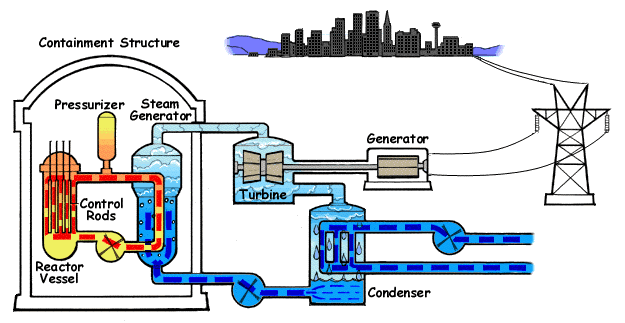What is a nuclear reactor?
A nuclear reactor is a device that harnesses the heat released when an atom changes its internal structure. Nuclear fusion is where 2 or more atoms are brought together to form a larger atom, and these reactors are still in development.
The more common type of reactor is one that uses nuclear fission, where an atom splits into 2 or more smaller atoms. It is found that the total mass of the smaller atoms is actually less than the mass of the original atom. The mass that is ‘lost’ in the fission process has actually been released as energy.
This was predicted by Albert Einstein’s famous equation of E = m c2 , which states that the energy released (E) will be the mass ‘lost’ (m) multiplied by the speed of light (c) multiplied again by the speed of light. As the speed of light is almost 300 million metres per second, it is clear that even a very small amount of energy ‘lost’ will result in a large amount of energy being released.
Nuclear reactors use that energy to generate electricity.
Note, however, that the fuel in a nuclear reactor is not at all like the fuel in a nuclear bomb and it is physical impossibility for a reactor to undergo a nuclear explosion. You can find out more about this in our page on Proliferation.
What reactors would suit Ireland?
Reactors that would be suitable for Ireland include the NuScale 50 MWe modular reactor, available from around 2030. Situated underwater in a large water tank, it needs no electricity to remain passively safe indefinitely. Groups of 12 modules would form 600 MWe units, 2 of which would be ideal replacements for Moneypoint. These could supply over a quarter of our current electricity needs.
Another is the 180 MWe B&W mPower™ reactor – a modular, passively safe, advanced light water reactor. See this technical update from 2013.
Westinghouse, manufacturer of the world’s most popular reactor currently being built, have also recently announced their intention to jointly develop a 225 MWe small modular reactor with Britain. This could be a hugely significant move for us as we could possibly take advantage of the regulatory and other ancillary processes that Britain would install to bring that project to the market.
The most advanced new small reactor design is a 200 MWe high temperature reactor (HTR-PM) currently being built in China, based on earlier design work in Germany and South Africa. Grid connection is due in 2021. The reactor is walk-away safe and has potential to generate the cheapest low-carbon electricity of all.
These small modular reactors are designed to be built and tested in factory and are easily shipped by barge, boat, rail or road to site, where they are assembled. This method will yield a 3-year build period and greatly increases the likelihood of the plants being erected on schedule and on budget. This leads to lower financing costs, which means the final cost of electricity is expected to lower than from some of the larger plants now being built in Europe.
The final cost will be influenced by a number of factors, including public and political support, legal challenges, good regulation, licensing and legislation, plant cost, finance rate and the operating and maintenance regime. The eventual cost of electricity could be halved by getting all these optimised.
As Ireland is likely to need the assistance of nuclear to ensure sustainable, secure and and affordable energy, it is in all our interests that we avoid unnecessarily increase the cost of our future nuclear supply. We do this by ensuring that we plan and execute the project correctly and with the support of our citizens. As not all citizens will support this or any other project, their concerns must be adequately resolved before commencing.
An interactive map and guide to the world’s nuclear-power producers
This guide from The Economist shows – for the 30 countries that currently use nuclear power – operational reactors, as well as those under construction and planned, the amount of electricity they produce, and the quantity of uranium they require to do so.
